Operation Barga Question 2022
VerifiedAdded on 2022/10/04
|11
|3021
|25
AI Summary
Contribute Materials
Your contribution can guide someone’s learning journey. Share your
documents today.
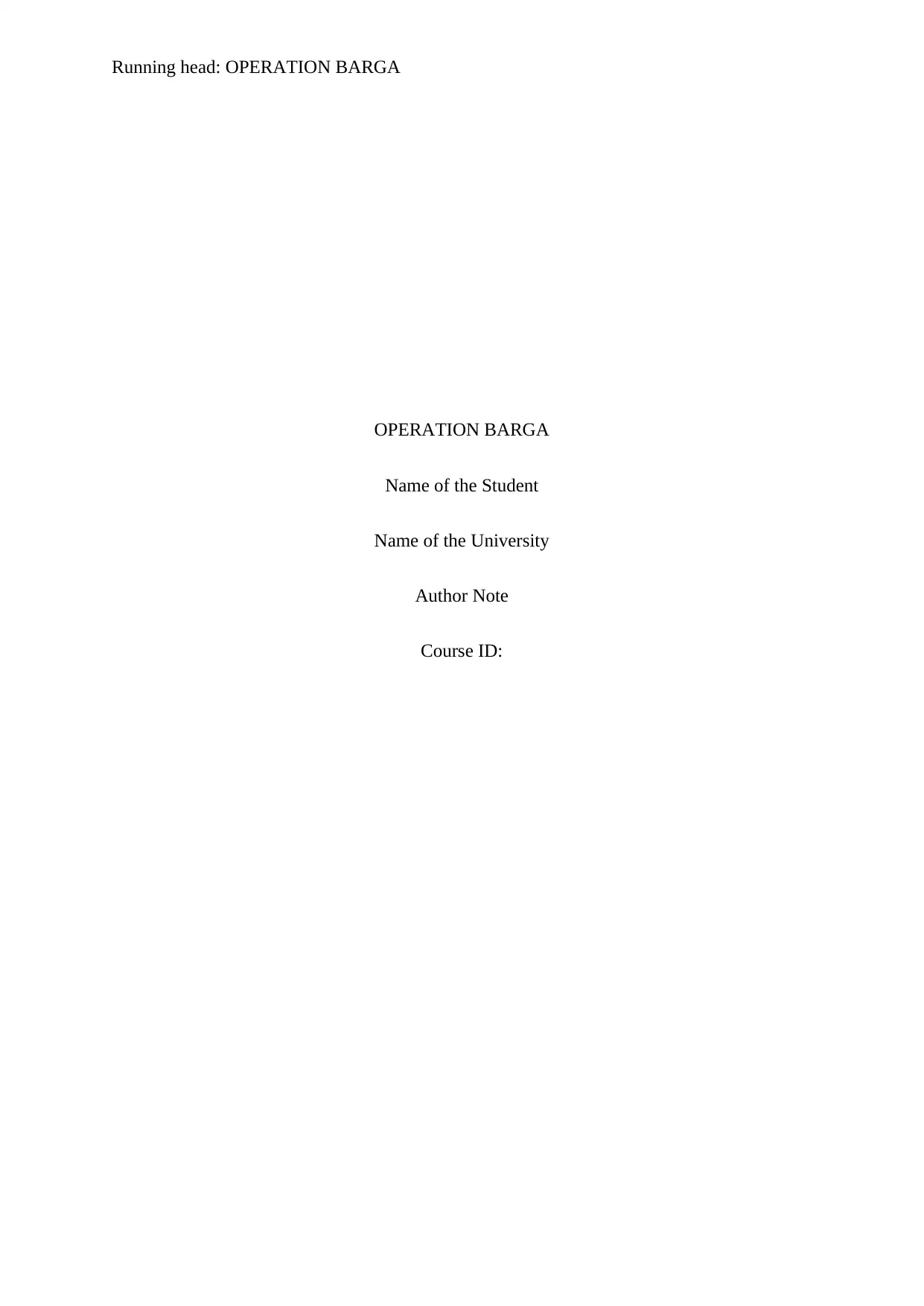
Running head: OPERATION BARGA
OPERATION BARGA
Name of the Student
Name of the University
Author Note
Course ID:
OPERATION BARGA
Name of the Student
Name of the University
Author Note
Course ID:
Secure Best Marks with AI Grader
Need help grading? Try our AI Grader for instant feedback on your assignments.
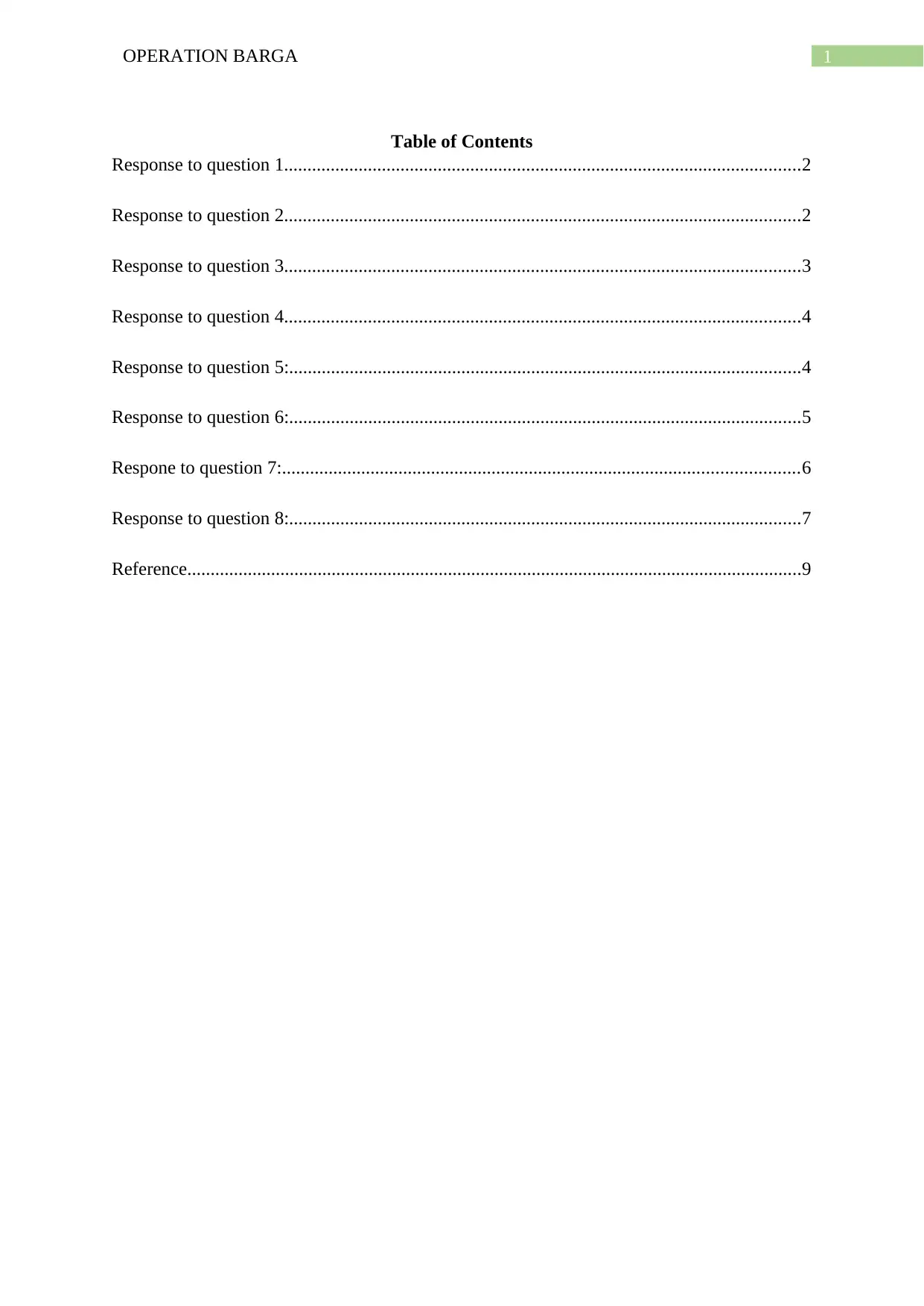
1OPERATION BARGA
Table of Contents
Response to question 1...............................................................................................................2
Response to question 2...............................................................................................................2
Response to question 3...............................................................................................................3
Response to question 4...............................................................................................................4
Response to question 5:..............................................................................................................4
Response to question 6:..............................................................................................................5
Respone to question 7:...............................................................................................................6
Response to question 8:..............................................................................................................7
Reference....................................................................................................................................9
Table of Contents
Response to question 1...............................................................................................................2
Response to question 2...............................................................................................................2
Response to question 3...............................................................................................................3
Response to question 4...............................................................................................................4
Response to question 5:..............................................................................................................4
Response to question 6:..............................................................................................................5
Respone to question 7:...............................................................................................................6
Response to question 8:..............................................................................................................7
Reference....................................................................................................................................9
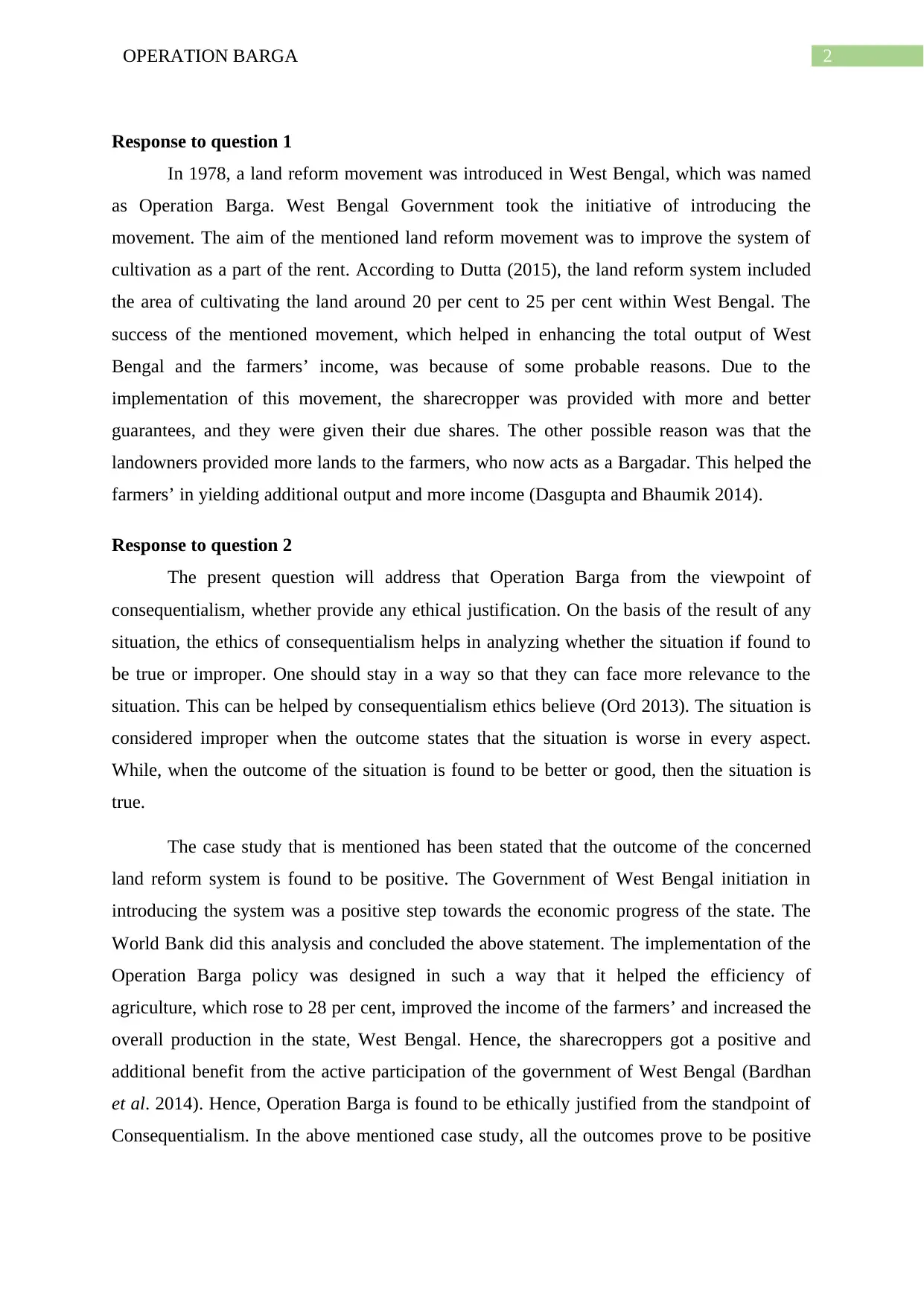
2OPERATION BARGA
Response to question 1
In 1978, a land reform movement was introduced in West Bengal, which was named
as Operation Barga. West Bengal Government took the initiative of introducing the
movement. The aim of the mentioned land reform movement was to improve the system of
cultivation as a part of the rent. According to Dutta (2015), the land reform system included
the area of cultivating the land around 20 per cent to 25 per cent within West Bengal. The
success of the mentioned movement, which helped in enhancing the total output of West
Bengal and the farmers’ income, was because of some probable reasons. Due to the
implementation of this movement, the sharecropper was provided with more and better
guarantees, and they were given their due shares. The other possible reason was that the
landowners provided more lands to the farmers, who now acts as a Bargadar. This helped the
farmers’ in yielding additional output and more income (Dasgupta and Bhaumik 2014).
Response to question 2
The present question will address that Operation Barga from the viewpoint of
consequentialism, whether provide any ethical justification. On the basis of the result of any
situation, the ethics of consequentialism helps in analyzing whether the situation if found to
be true or improper. One should stay in a way so that they can face more relevance to the
situation. This can be helped by consequentialism ethics believe (Ord 2013). The situation is
considered improper when the outcome states that the situation is worse in every aspect.
While, when the outcome of the situation is found to be better or good, then the situation is
true.
The case study that is mentioned has been stated that the outcome of the concerned
land reform system is found to be positive. The Government of West Bengal initiation in
introducing the system was a positive step towards the economic progress of the state. The
World Bank did this analysis and concluded the above statement. The implementation of the
Operation Barga policy was designed in such a way that it helped the efficiency of
agriculture, which rose to 28 per cent, improved the income of the farmers’ and increased the
overall production in the state, West Bengal. Hence, the sharecroppers got a positive and
additional benefit from the active participation of the government of West Bengal (Bardhan
et al. 2014). Hence, Operation Barga is found to be ethically justified from the standpoint of
Consequentialism. In the above mentioned case study, all the outcomes prove to be positive
Response to question 1
In 1978, a land reform movement was introduced in West Bengal, which was named
as Operation Barga. West Bengal Government took the initiative of introducing the
movement. The aim of the mentioned land reform movement was to improve the system of
cultivation as a part of the rent. According to Dutta (2015), the land reform system included
the area of cultivating the land around 20 per cent to 25 per cent within West Bengal. The
success of the mentioned movement, which helped in enhancing the total output of West
Bengal and the farmers’ income, was because of some probable reasons. Due to the
implementation of this movement, the sharecropper was provided with more and better
guarantees, and they were given their due shares. The other possible reason was that the
landowners provided more lands to the farmers, who now acts as a Bargadar. This helped the
farmers’ in yielding additional output and more income (Dasgupta and Bhaumik 2014).
Response to question 2
The present question will address that Operation Barga from the viewpoint of
consequentialism, whether provide any ethical justification. On the basis of the result of any
situation, the ethics of consequentialism helps in analyzing whether the situation if found to
be true or improper. One should stay in a way so that they can face more relevance to the
situation. This can be helped by consequentialism ethics believe (Ord 2013). The situation is
considered improper when the outcome states that the situation is worse in every aspect.
While, when the outcome of the situation is found to be better or good, then the situation is
true.
The case study that is mentioned has been stated that the outcome of the concerned
land reform system is found to be positive. The Government of West Bengal initiation in
introducing the system was a positive step towards the economic progress of the state. The
World Bank did this analysis and concluded the above statement. The implementation of the
Operation Barga policy was designed in such a way that it helped the efficiency of
agriculture, which rose to 28 per cent, improved the income of the farmers’ and increased the
overall production in the state, West Bengal. Hence, the sharecroppers got a positive and
additional benefit from the active participation of the government of West Bengal (Bardhan
et al. 2014). Hence, Operation Barga is found to be ethically justified from the standpoint of
Consequentialism. In the above mentioned case study, all the outcomes prove to be positive
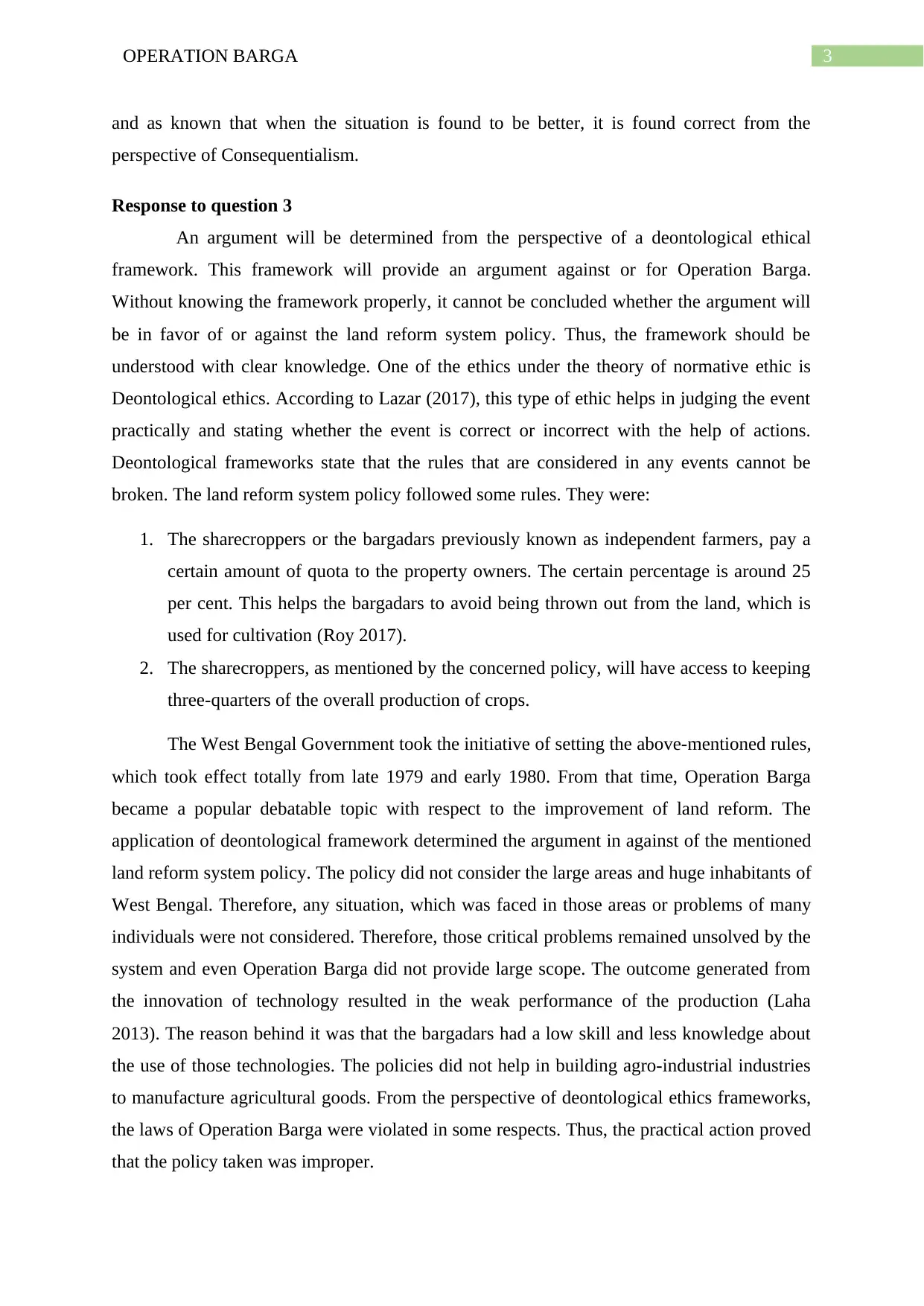
3OPERATION BARGA
and as known that when the situation is found to be better, it is found correct from the
perspective of Consequentialism.
Response to question 3
An argument will be determined from the perspective of a deontological ethical
framework. This framework will provide an argument against or for Operation Barga.
Without knowing the framework properly, it cannot be concluded whether the argument will
be in favor of or against the land reform system policy. Thus, the framework should be
understood with clear knowledge. One of the ethics under the theory of normative ethic is
Deontological ethics. According to Lazar (2017), this type of ethic helps in judging the event
practically and stating whether the event is correct or incorrect with the help of actions.
Deontological frameworks state that the rules that are considered in any events cannot be
broken. The land reform system policy followed some rules. They were:
1. The sharecroppers or the bargadars previously known as independent farmers, pay a
certain amount of quota to the property owners. The certain percentage is around 25
per cent. This helps the bargadars to avoid being thrown out from the land, which is
used for cultivation (Roy 2017).
2. The sharecroppers, as mentioned by the concerned policy, will have access to keeping
three-quarters of the overall production of crops.
The West Bengal Government took the initiative of setting the above-mentioned rules,
which took effect totally from late 1979 and early 1980. From that time, Operation Barga
became a popular debatable topic with respect to the improvement of land reform. The
application of deontological framework determined the argument in against of the mentioned
land reform system policy. The policy did not consider the large areas and huge inhabitants of
West Bengal. Therefore, any situation, which was faced in those areas or problems of many
individuals were not considered. Therefore, those critical problems remained unsolved by the
system and even Operation Barga did not provide large scope. The outcome generated from
the innovation of technology resulted in the weak performance of the production (Laha
2013). The reason behind it was that the bargadars had a low skill and less knowledge about
the use of those technologies. The policies did not help in building agro-industrial industries
to manufacture agricultural goods. From the perspective of deontological ethics frameworks,
the laws of Operation Barga were violated in some respects. Thus, the practical action proved
that the policy taken was improper.
and as known that when the situation is found to be better, it is found correct from the
perspective of Consequentialism.
Response to question 3
An argument will be determined from the perspective of a deontological ethical
framework. This framework will provide an argument against or for Operation Barga.
Without knowing the framework properly, it cannot be concluded whether the argument will
be in favor of or against the land reform system policy. Thus, the framework should be
understood with clear knowledge. One of the ethics under the theory of normative ethic is
Deontological ethics. According to Lazar (2017), this type of ethic helps in judging the event
practically and stating whether the event is correct or incorrect with the help of actions.
Deontological frameworks state that the rules that are considered in any events cannot be
broken. The land reform system policy followed some rules. They were:
1. The sharecroppers or the bargadars previously known as independent farmers, pay a
certain amount of quota to the property owners. The certain percentage is around 25
per cent. This helps the bargadars to avoid being thrown out from the land, which is
used for cultivation (Roy 2017).
2. The sharecroppers, as mentioned by the concerned policy, will have access to keeping
three-quarters of the overall production of crops.
The West Bengal Government took the initiative of setting the above-mentioned rules,
which took effect totally from late 1979 and early 1980. From that time, Operation Barga
became a popular debatable topic with respect to the improvement of land reform. The
application of deontological framework determined the argument in against of the mentioned
land reform system policy. The policy did not consider the large areas and huge inhabitants of
West Bengal. Therefore, any situation, which was faced in those areas or problems of many
individuals were not considered. Therefore, those critical problems remained unsolved by the
system and even Operation Barga did not provide large scope. The outcome generated from
the innovation of technology resulted in the weak performance of the production (Laha
2013). The reason behind it was that the bargadars had a low skill and less knowledge about
the use of those technologies. The policies did not help in building agro-industrial industries
to manufacture agricultural goods. From the perspective of deontological ethics frameworks,
the laws of Operation Barga were violated in some respects. Thus, the practical action proved
that the policy taken was improper.
Secure Best Marks with AI Grader
Need help grading? Try our AI Grader for instant feedback on your assignments.
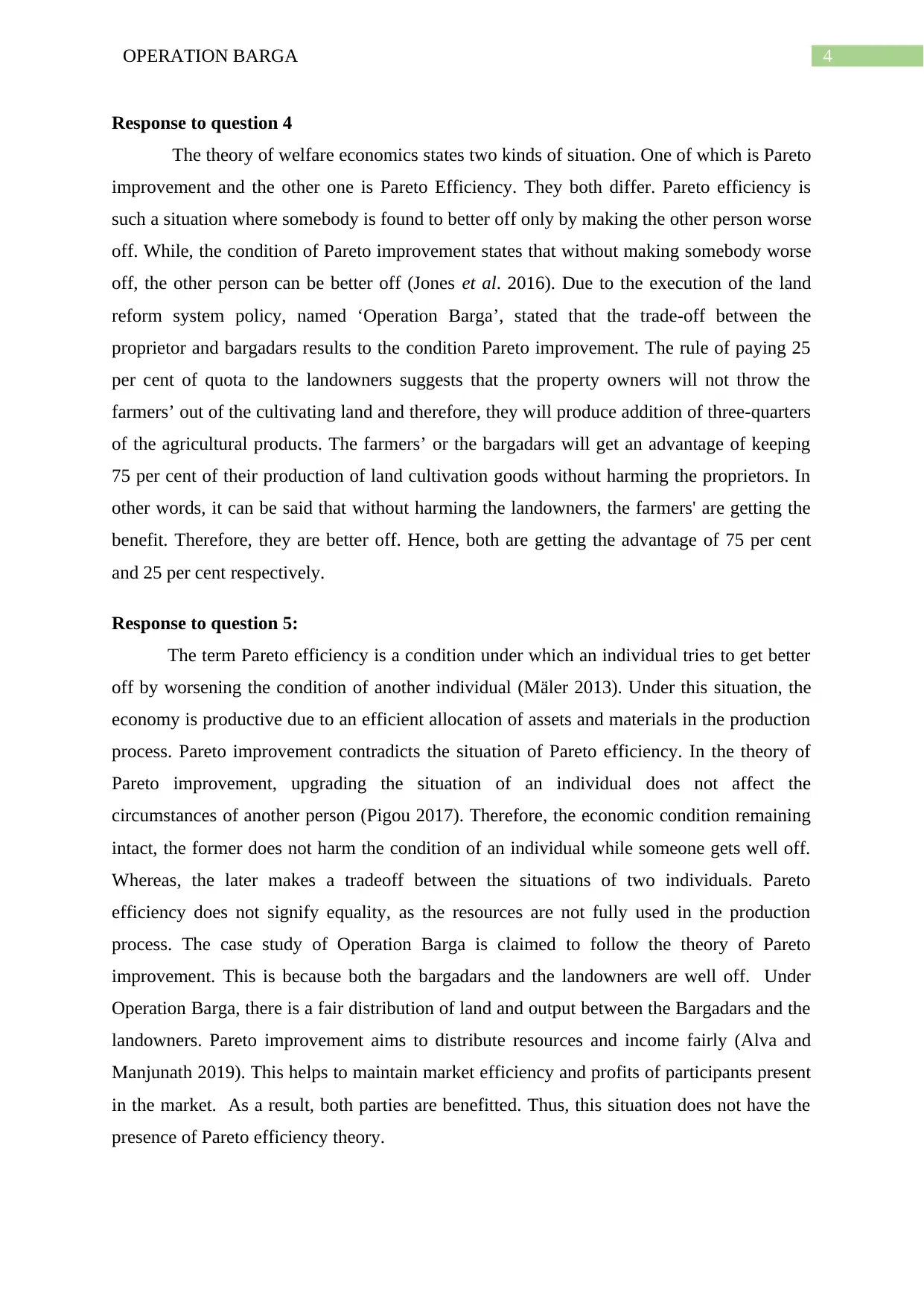
4OPERATION BARGA
Response to question 4
The theory of welfare economics states two kinds of situation. One of which is Pareto
improvement and the other one is Pareto Efficiency. They both differ. Pareto efficiency is
such a situation where somebody is found to better off only by making the other person worse
off. While, the condition of Pareto improvement states that without making somebody worse
off, the other person can be better off (Jones et al. 2016). Due to the execution of the land
reform system policy, named ‘Operation Barga’, stated that the trade-off between the
proprietor and bargadars results to the condition Pareto improvement. The rule of paying 25
per cent of quota to the landowners suggests that the property owners will not throw the
farmers’ out of the cultivating land and therefore, they will produce addition of three-quarters
of the agricultural products. The farmers’ or the bargadars will get an advantage of keeping
75 per cent of their production of land cultivation goods without harming the proprietors. In
other words, it can be said that without harming the landowners, the farmers' are getting the
benefit. Therefore, they are better off. Hence, both are getting the advantage of 75 per cent
and 25 per cent respectively.
Response to question 5:
The term Pareto efficiency is a condition under which an individual tries to get better
off by worsening the condition of another individual (Mäler 2013). Under this situation, the
economy is productive due to an efficient allocation of assets and materials in the production
process. Pareto improvement contradicts the situation of Pareto efficiency. In the theory of
Pareto improvement, upgrading the situation of an individual does not affect the
circumstances of another person (Pigou 2017). Therefore, the economic condition remaining
intact, the former does not harm the condition of an individual while someone gets well off.
Whereas, the later makes a tradeoff between the situations of two individuals. Pareto
efficiency does not signify equality, as the resources are not fully used in the production
process. The case study of Operation Barga is claimed to follow the theory of Pareto
improvement. This is because both the bargadars and the landowners are well off. Under
Operation Barga, there is a fair distribution of land and output between the Bargadars and the
landowners. Pareto improvement aims to distribute resources and income fairly (Alva and
Manjunath 2019). This helps to maintain market efficiency and profits of participants present
in the market. As a result, both parties are benefitted. Thus, this situation does not have the
presence of Pareto efficiency theory.
Response to question 4
The theory of welfare economics states two kinds of situation. One of which is Pareto
improvement and the other one is Pareto Efficiency. They both differ. Pareto efficiency is
such a situation where somebody is found to better off only by making the other person worse
off. While, the condition of Pareto improvement states that without making somebody worse
off, the other person can be better off (Jones et al. 2016). Due to the execution of the land
reform system policy, named ‘Operation Barga’, stated that the trade-off between the
proprietor and bargadars results to the condition Pareto improvement. The rule of paying 25
per cent of quota to the landowners suggests that the property owners will not throw the
farmers’ out of the cultivating land and therefore, they will produce addition of three-quarters
of the agricultural products. The farmers’ or the bargadars will get an advantage of keeping
75 per cent of their production of land cultivation goods without harming the proprietors. In
other words, it can be said that without harming the landowners, the farmers' are getting the
benefit. Therefore, they are better off. Hence, both are getting the advantage of 75 per cent
and 25 per cent respectively.
Response to question 5:
The term Pareto efficiency is a condition under which an individual tries to get better
off by worsening the condition of another individual (Mäler 2013). Under this situation, the
economy is productive due to an efficient allocation of assets and materials in the production
process. Pareto improvement contradicts the situation of Pareto efficiency. In the theory of
Pareto improvement, upgrading the situation of an individual does not affect the
circumstances of another person (Pigou 2017). Therefore, the economic condition remaining
intact, the former does not harm the condition of an individual while someone gets well off.
Whereas, the later makes a tradeoff between the situations of two individuals. Pareto
efficiency does not signify equality, as the resources are not fully used in the production
process. The case study of Operation Barga is claimed to follow the theory of Pareto
improvement. This is because both the bargadars and the landowners are well off. Under
Operation Barga, there is a fair distribution of land and output between the Bargadars and the
landowners. Pareto improvement aims to distribute resources and income fairly (Alva and
Manjunath 2019). This helps to maintain market efficiency and profits of participants present
in the market. As a result, both parties are benefitted. Thus, this situation does not have the
presence of Pareto efficiency theory.
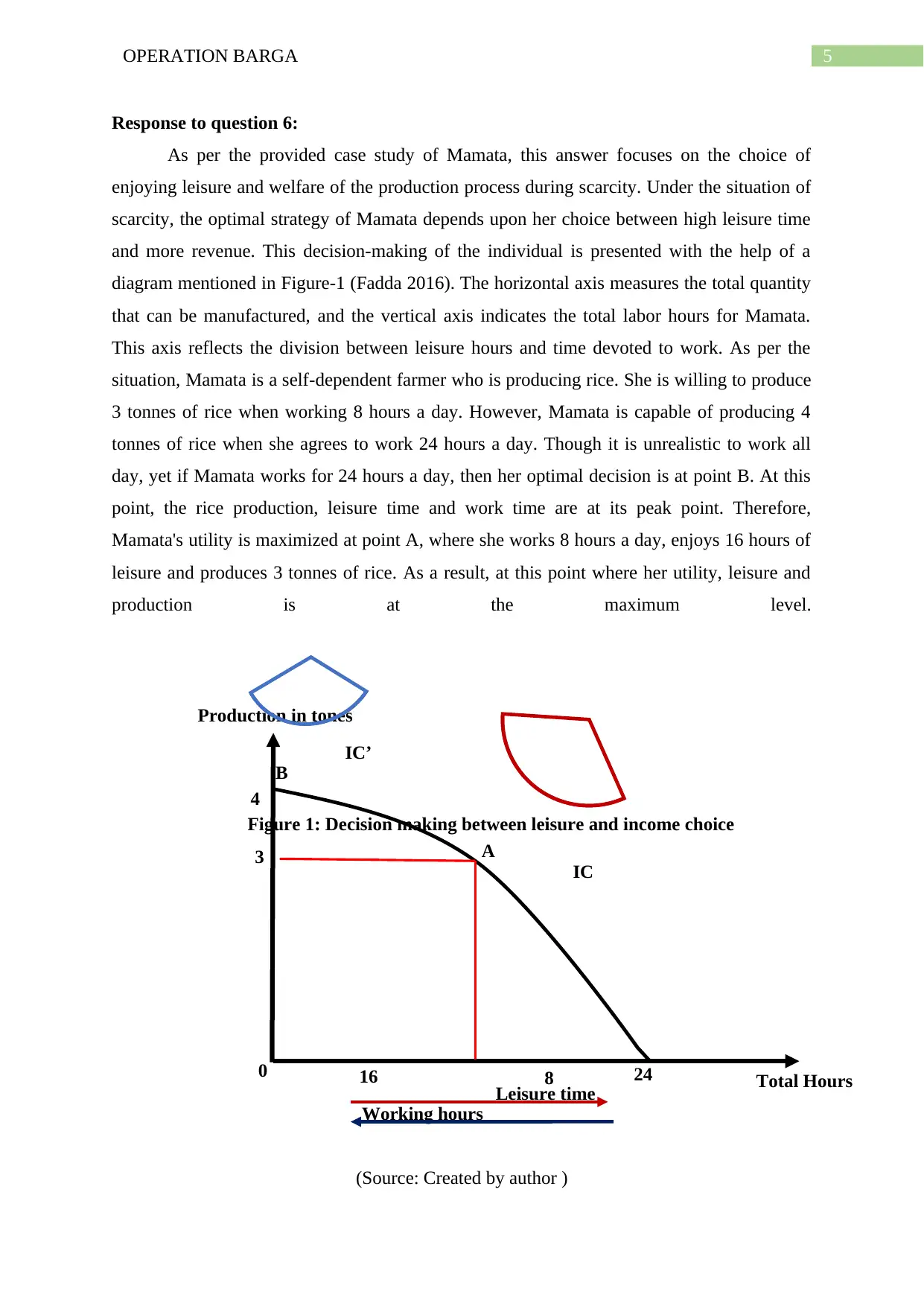
5OPERATION BARGA
8
A
4
24
IC
3
Total Hours
Working hours
Production in tones
Leisure time
B
IC’
160
Response to question 6:
As per the provided case study of Mamata, this answer focuses on the choice of
enjoying leisure and welfare of the production process during scarcity. Under the situation of
scarcity, the optimal strategy of Mamata depends upon her choice between high leisure time
and more revenue. This decision-making of the individual is presented with the help of a
diagram mentioned in Figure-1 (Fadda 2016). The horizontal axis measures the total quantity
that can be manufactured, and the vertical axis indicates the total labor hours for Mamata.
This axis reflects the division between leisure hours and time devoted to work. As per the
situation, Mamata is a self-dependent farmer who is producing rice. She is willing to produce
3 tonnes of rice when working 8 hours a day. However, Mamata is capable of producing 4
tonnes of rice when she agrees to work 24 hours a day. Though it is unrealistic to work all
day, yet if Mamata works for 24 hours a day, then her optimal decision is at point B. At this
point, the rice production, leisure time and work time are at its peak point. Therefore,
Mamata's utility is maximized at point A, where she works 8 hours a day, enjoys 16 hours of
leisure and produces 3 tonnes of rice. As a result, at this point where her utility, leisure and
production is at the maximum level.
(Source: Created by author )
Figure 1: Decision making between leisure and income choice
8
A
4
24
IC
3
Total Hours
Working hours
Production in tones
Leisure time
B
IC’
160
Response to question 6:
As per the provided case study of Mamata, this answer focuses on the choice of
enjoying leisure and welfare of the production process during scarcity. Under the situation of
scarcity, the optimal strategy of Mamata depends upon her choice between high leisure time
and more revenue. This decision-making of the individual is presented with the help of a
diagram mentioned in Figure-1 (Fadda 2016). The horizontal axis measures the total quantity
that can be manufactured, and the vertical axis indicates the total labor hours for Mamata.
This axis reflects the division between leisure hours and time devoted to work. As per the
situation, Mamata is a self-dependent farmer who is producing rice. She is willing to produce
3 tonnes of rice when working 8 hours a day. However, Mamata is capable of producing 4
tonnes of rice when she agrees to work 24 hours a day. Though it is unrealistic to work all
day, yet if Mamata works for 24 hours a day, then her optimal decision is at point B. At this
point, the rice production, leisure time and work time are at its peak point. Therefore,
Mamata's utility is maximized at point A, where she works 8 hours a day, enjoys 16 hours of
leisure and produces 3 tonnes of rice. As a result, at this point where her utility, leisure and
production is at the maximum level.
(Source: Created by author )
Figure 1: Decision making between leisure and income choice
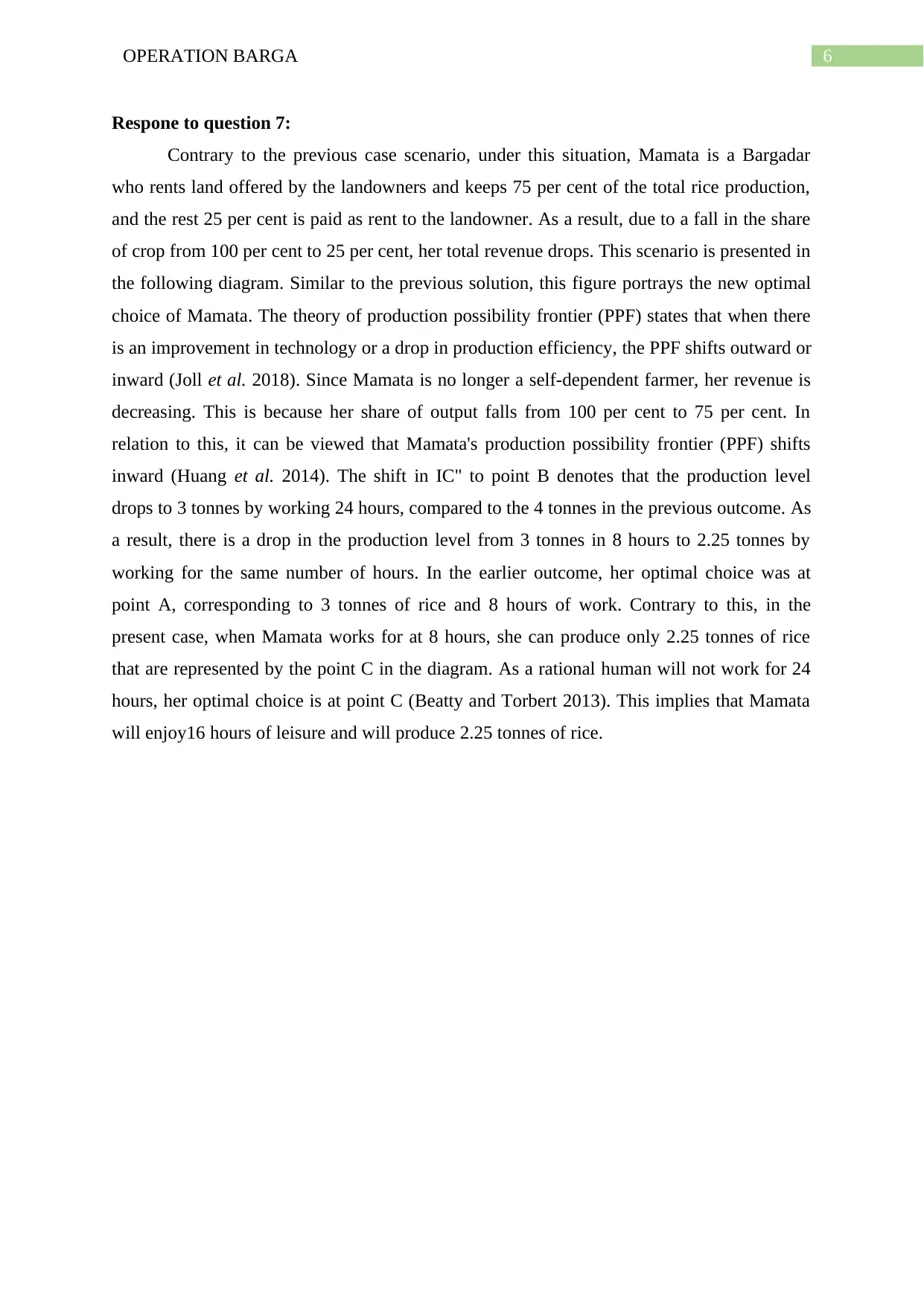
6OPERATION BARGA
Respone to question 7:
Contrary to the previous case scenario, under this situation, Mamata is a Bargadar
who rents land offered by the landowners and keeps 75 per cent of the total rice production,
and the rest 25 per cent is paid as rent to the landowner. As a result, due to a fall in the share
of crop from 100 per cent to 25 per cent, her total revenue drops. This scenario is presented in
the following diagram. Similar to the previous solution, this figure portrays the new optimal
choice of Mamata. The theory of production possibility frontier (PPF) states that when there
is an improvement in technology or a drop in production efficiency, the PPF shifts outward or
inward (Joll et al. 2018). Since Mamata is no longer a self-dependent farmer, her revenue is
decreasing. This is because her share of output falls from 100 per cent to 75 per cent. In
relation to this, it can be viewed that Mamata's production possibility frontier (PPF) shifts
inward (Huang et al. 2014). The shift in IC" to point B denotes that the production level
drops to 3 tonnes by working 24 hours, compared to the 4 tonnes in the previous outcome. As
a result, there is a drop in the production level from 3 tonnes in 8 hours to 2.25 tonnes by
working for the same number of hours. In the earlier outcome, her optimal choice was at
point A, corresponding to 3 tonnes of rice and 8 hours of work. Contrary to this, in the
present case, when Mamata works for at 8 hours, she can produce only 2.25 tonnes of rice
that are represented by the point C in the diagram. As a rational human will not work for 24
hours, her optimal choice is at point C (Beatty and Torbert 2013). This implies that Mamata
will enjoy16 hours of leisure and will produce 2.25 tonnes of rice.
Respone to question 7:
Contrary to the previous case scenario, under this situation, Mamata is a Bargadar
who rents land offered by the landowners and keeps 75 per cent of the total rice production,
and the rest 25 per cent is paid as rent to the landowner. As a result, due to a fall in the share
of crop from 100 per cent to 25 per cent, her total revenue drops. This scenario is presented in
the following diagram. Similar to the previous solution, this figure portrays the new optimal
choice of Mamata. The theory of production possibility frontier (PPF) states that when there
is an improvement in technology or a drop in production efficiency, the PPF shifts outward or
inward (Joll et al. 2018). Since Mamata is no longer a self-dependent farmer, her revenue is
decreasing. This is because her share of output falls from 100 per cent to 75 per cent. In
relation to this, it can be viewed that Mamata's production possibility frontier (PPF) shifts
inward (Huang et al. 2014). The shift in IC" to point B denotes that the production level
drops to 3 tonnes by working 24 hours, compared to the 4 tonnes in the previous outcome. As
a result, there is a drop in the production level from 3 tonnes in 8 hours to 2.25 tonnes by
working for the same number of hours. In the earlier outcome, her optimal choice was at
point A, corresponding to 3 tonnes of rice and 8 hours of work. Contrary to this, in the
present case, when Mamata works for at 8 hours, she can produce only 2.25 tonnes of rice
that are represented by the point C in the diagram. As a rational human will not work for 24
hours, her optimal choice is at point C (Beatty and Torbert 2013). This implies that Mamata
will enjoy16 hours of leisure and will produce 2.25 tonnes of rice.
Paraphrase This Document
Need a fresh take? Get an instant paraphrase of this document with our AI Paraphraser
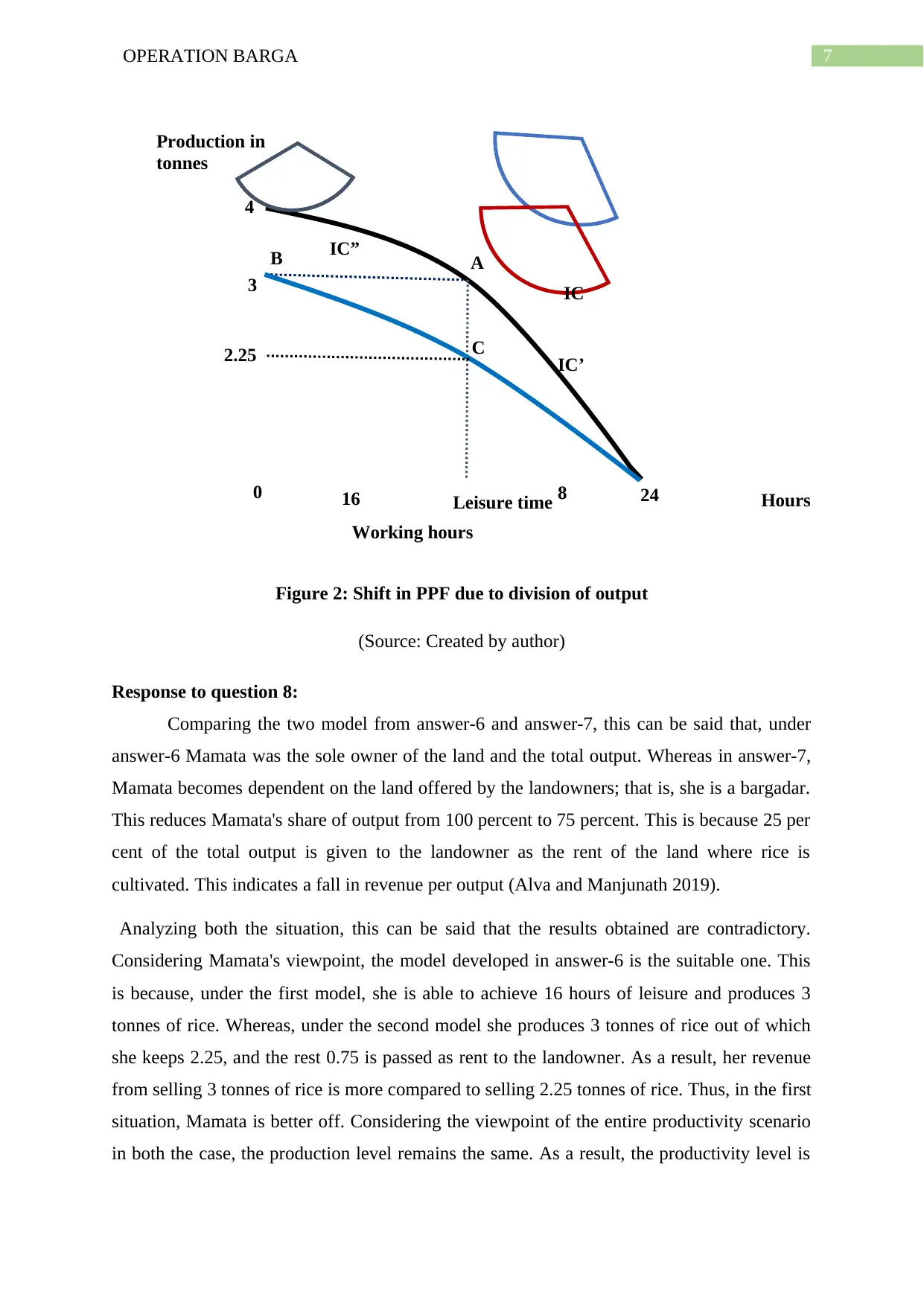
7OPERATION BARGA
IC
IC’
A
C
Production in
tonnes
4
3
2.25
24 HoursLeisure time
Working hours
B IC”
8160
Figure 2: Shift in PPF due to division of output
(Source: Created by author)
Response to question 8:
Comparing the two model from answer-6 and answer-7, this can be said that, under
answer-6 Mamata was the sole owner of the land and the total output. Whereas in answer-7,
Mamata becomes dependent on the land offered by the landowners; that is, she is a bargadar.
This reduces Mamata's share of output from 100 percent to 75 percent. This is because 25 per
cent of the total output is given to the landowner as the rent of the land where rice is
cultivated. This indicates a fall in revenue per output (Alva and Manjunath 2019).
Analyzing both the situation, this can be said that the results obtained are contradictory.
Considering Mamata's viewpoint, the model developed in answer-6 is the suitable one. This
is because, under the first model, she is able to achieve 16 hours of leisure and produces 3
tonnes of rice. Whereas, under the second model she produces 3 tonnes of rice out of which
she keeps 2.25, and the rest 0.75 is passed as rent to the landowner. As a result, her revenue
from selling 3 tonnes of rice is more compared to selling 2.25 tonnes of rice. Thus, in the first
situation, Mamata is better off. Considering the viewpoint of the entire productivity scenario
in both the case, the production level remains the same. As a result, the productivity level is
IC
IC’
A
C
Production in
tonnes
4
3
2.25
24 HoursLeisure time
Working hours
B IC”
8160
Figure 2: Shift in PPF due to division of output
(Source: Created by author)
Response to question 8:
Comparing the two model from answer-6 and answer-7, this can be said that, under
answer-6 Mamata was the sole owner of the land and the total output. Whereas in answer-7,
Mamata becomes dependent on the land offered by the landowners; that is, she is a bargadar.
This reduces Mamata's share of output from 100 percent to 75 percent. This is because 25 per
cent of the total output is given to the landowner as the rent of the land where rice is
cultivated. This indicates a fall in revenue per output (Alva and Manjunath 2019).
Analyzing both the situation, this can be said that the results obtained are contradictory.
Considering Mamata's viewpoint, the model developed in answer-6 is the suitable one. This
is because, under the first model, she is able to achieve 16 hours of leisure and produces 3
tonnes of rice. Whereas, under the second model she produces 3 tonnes of rice out of which
she keeps 2.25, and the rest 0.75 is passed as rent to the landowner. As a result, her revenue
from selling 3 tonnes of rice is more compared to selling 2.25 tonnes of rice. Thus, in the first
situation, Mamata is better off. Considering the viewpoint of the entire productivity scenario
in both the case, the production level remains the same. As a result, the productivity level is
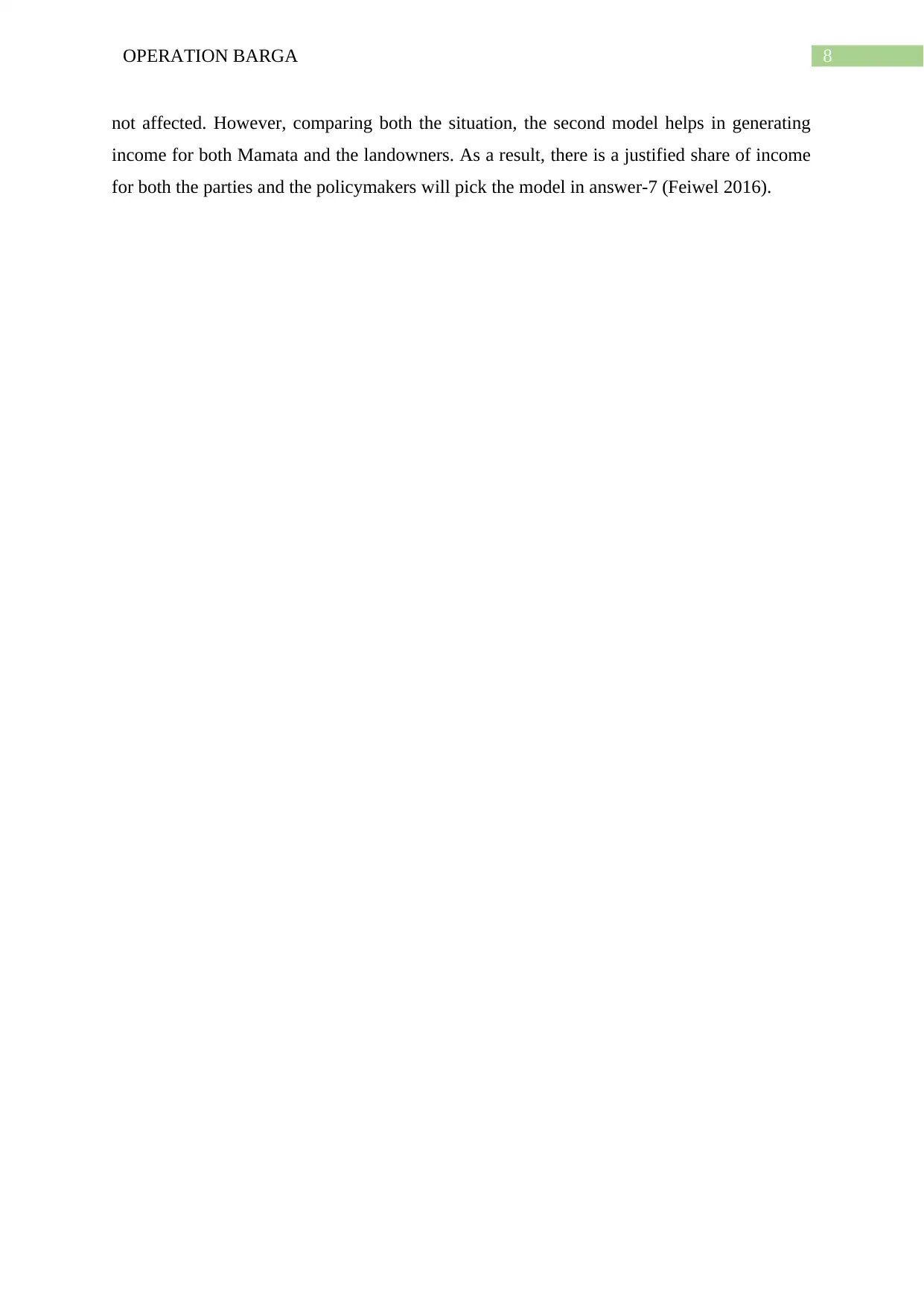
8OPERATION BARGA
not affected. However, comparing both the situation, the second model helps in generating
income for both Mamata and the landowners. As a result, there is a justified share of income
for both the parties and the policymakers will pick the model in answer-7 (Feiwel 2016).
not affected. However, comparing both the situation, the second model helps in generating
income for both Mamata and the landowners. As a result, there is a justified share of income
for both the parties and the policymakers will pick the model in answer-7 (Feiwel 2016).
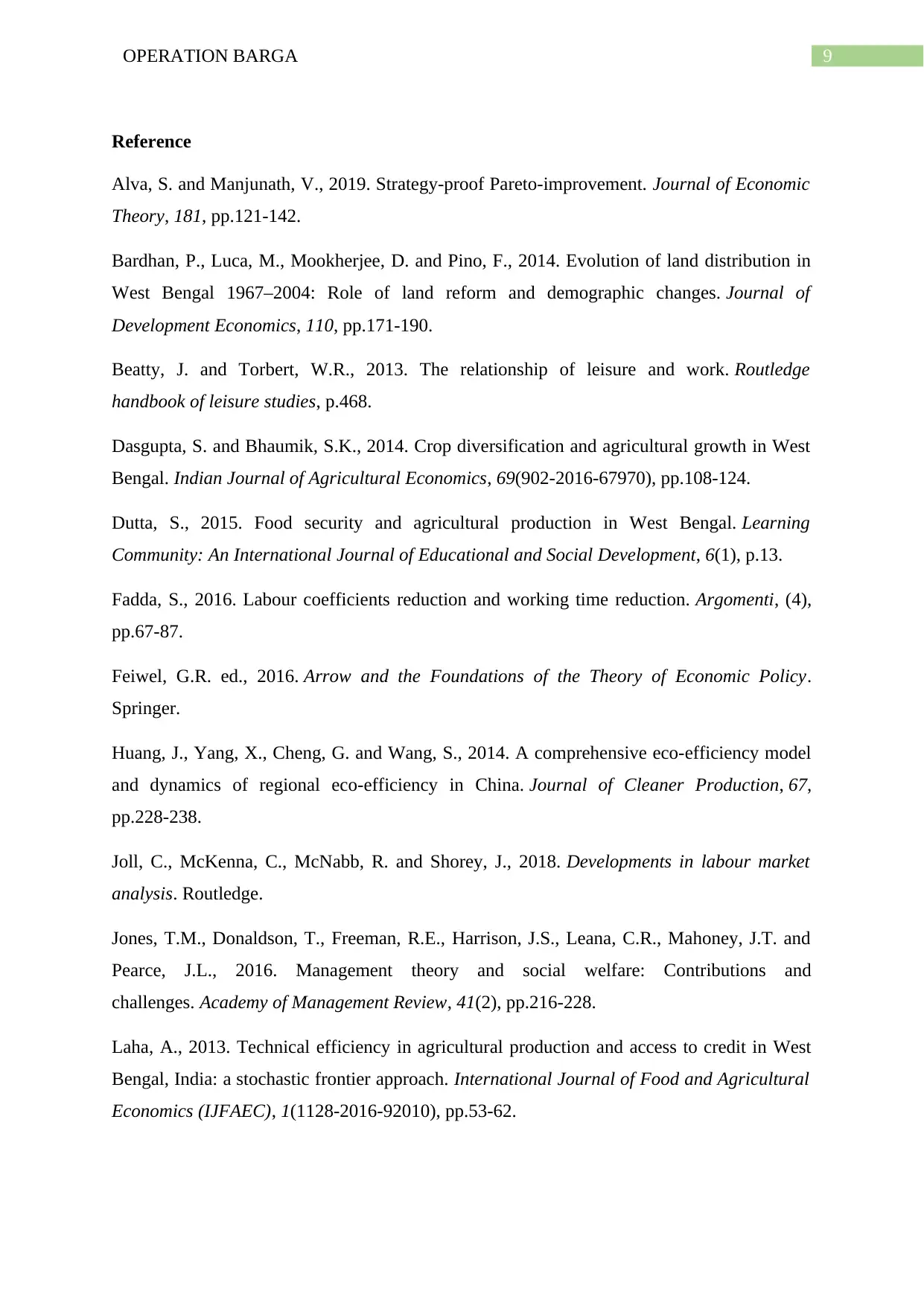
9OPERATION BARGA
Reference
Alva, S. and Manjunath, V., 2019. Strategy-proof Pareto-improvement. Journal of Economic
Theory, 181, pp.121-142.
Bardhan, P., Luca, M., Mookherjee, D. and Pino, F., 2014. Evolution of land distribution in
West Bengal 1967–2004: Role of land reform and demographic changes. Journal of
Development Economics, 110, pp.171-190.
Beatty, J. and Torbert, W.R., 2013. The relationship of leisure and work. Routledge
handbook of leisure studies, p.468.
Dasgupta, S. and Bhaumik, S.K., 2014. Crop diversification and agricultural growth in West
Bengal. Indian Journal of Agricultural Economics, 69(902-2016-67970), pp.108-124.
Dutta, S., 2015. Food security and agricultural production in West Bengal. Learning
Community: An International Journal of Educational and Social Development, 6(1), p.13.
Fadda, S., 2016. Labour coefficients reduction and working time reduction. Argomenti, (4),
pp.67-87.
Feiwel, G.R. ed., 2016. Arrow and the Foundations of the Theory of Economic Policy.
Springer.
Huang, J., Yang, X., Cheng, G. and Wang, S., 2014. A comprehensive eco-efficiency model
and dynamics of regional eco-efficiency in China. Journal of Cleaner Production, 67,
pp.228-238.
Joll, C., McKenna, C., McNabb, R. and Shorey, J., 2018. Developments in labour market
analysis. Routledge.
Jones, T.M., Donaldson, T., Freeman, R.E., Harrison, J.S., Leana, C.R., Mahoney, J.T. and
Pearce, J.L., 2016. Management theory and social welfare: Contributions and
challenges. Academy of Management Review, 41(2), pp.216-228.
Laha, A., 2013. Technical efficiency in agricultural production and access to credit in West
Bengal, India: a stochastic frontier approach. International Journal of Food and Agricultural
Economics (IJFAEC), 1(1128-2016-92010), pp.53-62.
Reference
Alva, S. and Manjunath, V., 2019. Strategy-proof Pareto-improvement. Journal of Economic
Theory, 181, pp.121-142.
Bardhan, P., Luca, M., Mookherjee, D. and Pino, F., 2014. Evolution of land distribution in
West Bengal 1967–2004: Role of land reform and demographic changes. Journal of
Development Economics, 110, pp.171-190.
Beatty, J. and Torbert, W.R., 2013. The relationship of leisure and work. Routledge
handbook of leisure studies, p.468.
Dasgupta, S. and Bhaumik, S.K., 2014. Crop diversification and agricultural growth in West
Bengal. Indian Journal of Agricultural Economics, 69(902-2016-67970), pp.108-124.
Dutta, S., 2015. Food security and agricultural production in West Bengal. Learning
Community: An International Journal of Educational and Social Development, 6(1), p.13.
Fadda, S., 2016. Labour coefficients reduction and working time reduction. Argomenti, (4),
pp.67-87.
Feiwel, G.R. ed., 2016. Arrow and the Foundations of the Theory of Economic Policy.
Springer.
Huang, J., Yang, X., Cheng, G. and Wang, S., 2014. A comprehensive eco-efficiency model
and dynamics of regional eco-efficiency in China. Journal of Cleaner Production, 67,
pp.228-238.
Joll, C., McKenna, C., McNabb, R. and Shorey, J., 2018. Developments in labour market
analysis. Routledge.
Jones, T.M., Donaldson, T., Freeman, R.E., Harrison, J.S., Leana, C.R., Mahoney, J.T. and
Pearce, J.L., 2016. Management theory and social welfare: Contributions and
challenges. Academy of Management Review, 41(2), pp.216-228.
Laha, A., 2013. Technical efficiency in agricultural production and access to credit in West
Bengal, India: a stochastic frontier approach. International Journal of Food and Agricultural
Economics (IJFAEC), 1(1128-2016-92010), pp.53-62.
Secure Best Marks with AI Grader
Need help grading? Try our AI Grader for instant feedback on your assignments.
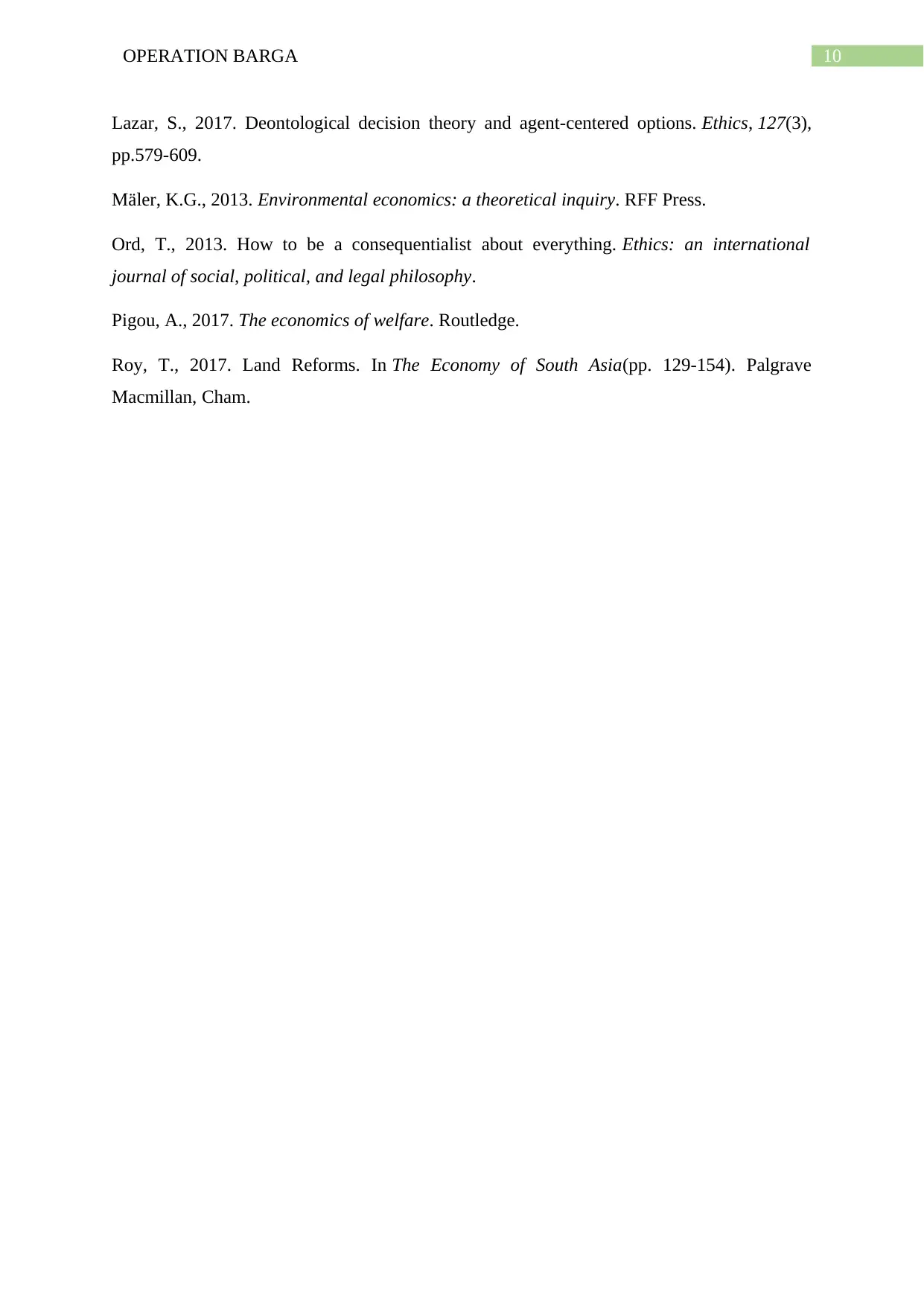
10OPERATION BARGA
Lazar, S., 2017. Deontological decision theory and agent-centered options. Ethics, 127(3),
pp.579-609.
Mäler, K.G., 2013. Environmental economics: a theoretical inquiry. RFF Press.
Ord, T., 2013. How to be a consequentialist about everything. Ethics: an international
journal of social, political, and legal philosophy.
Pigou, A., 2017. The economics of welfare. Routledge.
Roy, T., 2017. Land Reforms. In The Economy of South Asia(pp. 129-154). Palgrave
Macmillan, Cham.
Lazar, S., 2017. Deontological decision theory and agent-centered options. Ethics, 127(3),
pp.579-609.
Mäler, K.G., 2013. Environmental economics: a theoretical inquiry. RFF Press.
Ord, T., 2013. How to be a consequentialist about everything. Ethics: an international
journal of social, political, and legal philosophy.
Pigou, A., 2017. The economics of welfare. Routledge.
Roy, T., 2017. Land Reforms. In The Economy of South Asia(pp. 129-154). Palgrave
Macmillan, Cham.
1 out of 11
Related Documents
Your All-in-One AI-Powered Toolkit for Academic Success.
+13062052269
info@desklib.com
Available 24*7 on WhatsApp / Email
![[object Object]](/_next/static/media/star-bottom.7253800d.svg)
Unlock your academic potential
© 2024 | Zucol Services PVT LTD | All rights reserved.





